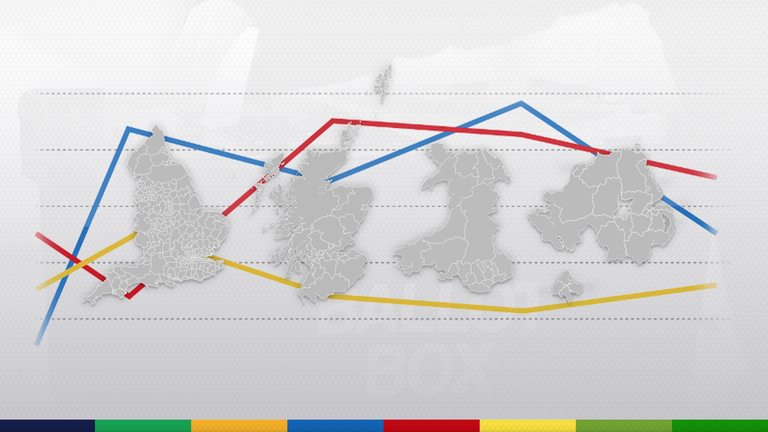A country divided: The story of the local elections 2022 in maps and charts
Sky News analysis of the local election results shows that although the Conservatives have lost more than 450 seats, this does not translate into total triumph for Labour.
Saturday 7 May 2022 07:45, UK
The totemic London councils of Wandsworth, Westminster and Barnet, as well as the bellwether council of Southampton, all fell from the Conservatives to Labour.
They were among almost 40 councils to change hands across England, Scotland and Wales, 13 of which were from the Conservatives.
But Labour struggled to truly seize advantage of the Tory decline. In England they gained fewer seats than the Greens and fewer councils than the Lib Dems, as the fortunes of different parties varied in different parts of the country.
Conservative losses in the south of England were largely to the Greens and Lib Dems.
The Lib Dems gained control of Gosport, Woking and Somerset councils in the south, as well as Hull and Westmorland & Furness, as part of a promising night overall.
Labour lost vote share in every other part of the UK apart from London.
Check the result where you live
Labour will be buoyed by results in specific councils that point towards potential gains in a general election.
Cumberland is a new council, formed from Allerdale, Carlisle and Copeland, so it's not right to call it a Labour gain. But the Conservatives were the biggest party in two of those three former councils and crucially have all three MPs in the area.
Looking towards the Midlands, in Wolverhampton there was no change in the number of council seats under Labour control, but their vote share increased compared to the general election and last year's locals.
They would have taken both Wolverhampton constituencies from the Conservatives if this was a general election.
The Labour performance in neighbouring Sandwell indicates that they would also have gained one of two seats in West Bromwich.
Based on the overall results, however, they would still be some way from challenging for an outright Commons win.
Making history
The election will be remembered best for those historic wins in London.
Wandsworth had been in Tory hands since 1978, and there had never been a Labour council in either Barnet or Westminster, since their creation 58 years ago.
Labour's dominance in London is particularly concerning for the Conservatives given that 2018, when these seats were last up, was their worst performance in the capital since 1964 when the boroughs were first established.
This chart shows how far ahead the Conservatives were in Westminster throughout recent decades - you can select a council you're interested in from the dropdown list.
Overall, almost 400 Tory councillors lost their seats in England, offset by just 54 gains, fewer than any of the other significant parties.
It wasn't much better in Scotland. Labour came second behind the SNP and gained control of West Dunbartonshire council.
And in Wales, the Conservatives failed to take a single seat they didn't control in 2018, losing 67.
Brexit vote trends still relevant
Since the EU referendum in 2016 we've become used to dramatic shifts in voting patterns. It seems from today's results that some of those trends might be baked into the baseline by now.
Sky News analysis of hundreds of English ward results shows that the Tories are now losing votes even in the strongest Leave-voting areas, although they are performing better there than in places that voted Remain.
The Lib Dems are making gains at Conservative expense in seats, especially in the south, where more people went to university.
